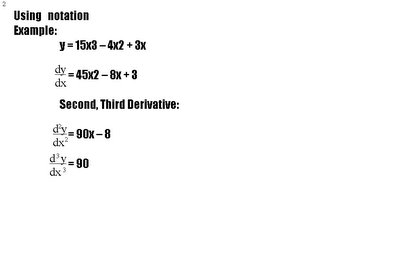3.7 Higher Differentiation
There were three main concepts in this section:
There were three main concepts in this section:
1. learning how to take second, third, fourth (etc) derivatives
2. New Notation for Higher Differentiation (dy/dx)
3. Relating the 2nd derivatives to motion and acceleration
Second, Third and Fourth Derivatives
Example:

Higher Derivatives:

Using dy/dx notation
Example:

Another Example:
y = sin (x)
y ′ = cos (x)
y ′′ = -sin (x)
y ′′′ = -cos (x)
y(4) = sin (x)
y(121) = cos (x)
The Second Derivative explains how the slope is changing. It tells us whether the graph is getting steeper or flattening out. In motion, the second derivative is used to measure acceleration.
s′ = v - the derivative of the distance equation is the velocity
v′ = a - the derivative of the velocity equation is the acceleration
s′′ = a - the second derivative of the distance equation is also the acceleration
Motion Example:
Initial Velocity--after one second-- Final Velocity--------- acceleration
10 mph------------------------------------ 20 mph--------------- +10 mph/sec
10 mph------------------------------------ 0 mph----------------- (-10) mph/sec
-10 mph---------------------------------- (-20) mph------------- (-10) mph/sec
Speed vs. Velocity
Speed = the magnitude of the velocity vector. It lacks direction.
When the change in velocity and the acceleration have the same sign (positive or negative), then the speed is increasing
Example:
Find the velocity and acceleration equation:

Find when the particle is speeding up:
-First find when the particle is at rest.
v = 3(t – 1)(t – 3)
-the velocity is equal to zero at 1 second and then at 3 seconds
-Then, test the intervals of velocity
- between 0 and 1: positive
- between 1 and 3: negative
- greater than 3: positive
-Finally, find when the acceleration is going to be 0
- a = 0 at 2 seconds
- Compute when acceleration is going to be positive or negative
- below 2 seconds: negative
- greater than 2 seconds: positive
-When the signs match, the particle is speeding up
So: 1 < t < 2 and t > 3
Here is a link for more information:
http://www.intmath.com/Diff/9_HiDe.php
SO there's the end of the blog for today folks.
-Lauren
Here's something to make you all very happy that it's Thursday:

DOESN'T IT MAKE YOU FEEL ALL WARM AND FUZZY INSIDE??
JAMES, have fun with the next one.

1 Comments:
Hello Vons!
I would like to congratulate you on the following:
1) The use of a non-Times New Roman font for your equation graphics.
2) Your inclusion of the Grey's Anatomy Season Two DVD Cover. Bravo!
3)Now for something actually relevant. I think you organized your blog very clearly. Everything is labeled and done in a categorical, linear way. It makes it easy to look at and easy to understand. You are a good explainer.
Post a Comment
<< Home